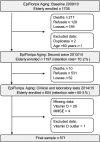Association between lower serum vitamin D (25-hydroxy-cholecalciferol) concentrations and cognitive impairment in older adults: data from a populational-based cohort study in a middle-income country
- PMID: 34689855
- PMCID: PMC9991716
- DOI: 10.1017/S1368980021004407
Association between lower serum vitamin D (25-hydroxy-cholecalciferol) concentrations and cognitive impairment in older adults: data from a populational-based cohort study in a middle-income country
Abstract
Objective: To investigate the association between serum vitamin D (25-hydroxy-cholecalciferol) (25(OH)D) concentrations and cognitive impairment in older adults living in Southern Brazil.
Design: Cross-sectional analysis using data from the second follow-up wave of the populational-based EpiFloripa Aging Cohort Study was collected in 2013-2014.
Setting: Cognitive impairment was evaluated using the Mini-Mental State Examination (MMSE). Blood samples were collected to measure serum vitamin D concentrations using a chemiluminescent microparticle immunoassay. Vitamin D concentrations were distributed in quartiles (Q1: 4·0-20·7 ng/ml; Q2: 20·8-26·6 ng/ml; Q3: 26·7-32·0 ng/ml and Q4: 32·1-60·1 ng/ml), and its association with cognitive impairment was tested by crude and adjusted logistic regression (sociodemographic, behavioural and health aspects) using Q4 as a reference group.
Participants: 200 men and 371 women aged 60 years or older participated in this study.
Results: The prevalence of probable cognitive impairment was 21·7 %. Those without cognitive impairment had a higher mean of vitamin D serum concentrations (26·8 v. 24·6, P = 0·014). In the crude analysis, only individuals in Q2 of vitamin D presented an increased risk for probable cognitive impairment compared with Q4 (highest quartile) (OR 2·65, 95 % CI 1·46, 4·81), remaining significant in the adjusted analysis (OR 6·04, 95 % CI 2·78, 13·13). While Q1 (lowest quartile) was not associated in the crude analysis, but when adjusted, an increased risk of cognitive impairment was observed.
Conclusion: The lowest quartile of vitamin D was directly associated with probable cognitive impairment in older adults in Southern Brazil. More studies are needed to investigate whether maintaining adequate serum levels may represent a significant factor in preventing age-related neurological disorders as well as to verify the need for new cutoff points for this age group.
Keywords: 25-hydroxy-cholecalciferol; Aged; Aging; Cognitive impairment; Vitamin D.
Figures


References
-
- World Health Organization (2017) Population Ageing and Longevity. Global Strategy and Action Plan on Ageing and Health. http://www.who.int/ageing/global-strategy/en (accessed April 2020).
-
- Alves LC, Leite IC & Machado CJ (2008) The concept and measurement of functional disability in the elderly population: a literature review. Cien Saude Colet 13, 1199–1207. - PubMed
-
- World Health Organization (2017) Mental Health of Older Adults. https://www.who.int/news-room/fact-sheets/detail/mental-health-of-older-... (accessed April 2020).
-
- Alzheimer’s Disease International (2019) World Alzheimer Report 2019 Attitudes to dementia. https://www.alzint.org/resource/world-alzheimer-report-2019/ (accessed April 2021).
Publication types
MeSH terms
Substances
LinkOut - more resources
Full Text Sources
Medical

